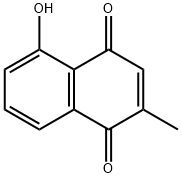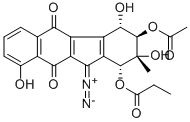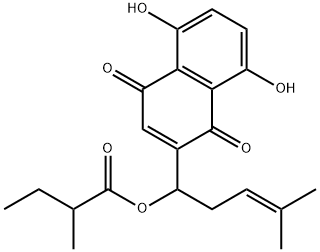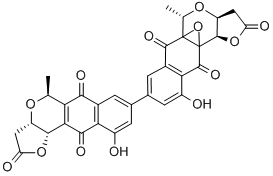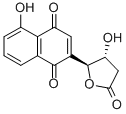Plumbagin from <I>Plumbago indica</I> , 98% , 481-42-5
Synonym(s):
5-Hydroxy-2-methyl-1,4-naphthoquinone
CAS NO.:481-42-5
Empirical Formula: C11H8O3
Molecular Weight: 188.18
MDL number: MFCD00001682
EINECS: 207-569-6
| Pack Size | Price | Stock | Quantity |
| 100MG | RMB271.20 | In Stock |
|
| 250MG | RMB399.20 | In Stock |
|
| 1G | RMB959.20 | In Stock |
|
| 5g | RMB3839.20 | In Stock |
|
| others | Enquire |
PRODUCT Properties
| Melting point: | 76-78 °C(lit.) |
| Boiling point: | 283.17°C (rough estimate) |
| Density | 1.354 |
| refractive index | 1.6310 (estimate) |
| storage temp. | -20°C |
| solubility | very faint turbidity in hot Methanol |
| form | Crystals or Crystalline Powder |
| pka | 6.70±0.20(Predicted) |
| color | Orange |
| biological source | Plumbago indica |
| Merck | 7538 |
| Stability: | Hygroscopic |
| LogP | 2.450 (est) |
| EPA Substance Registry System | 1,4-Naphthalenedione, 5-hydroxy-2-methyl- (481-42-5) |
Description and Uses
Plumbagin is a natural 1,4-naphthoquinone first isolated from plants of the genus Plumbago. It has diverse effects in cells and animals. Plumbagin causes the generation of reactive oxygen species and induces apoptosis in cancer cells. It activates signaling through Nrf2 and the antioxidant response element, inducing the expression of Nrf2 target genes, including NQO1 and heme oxygenase-1 in cultured neuronal cells. Plumbagin also inhibits NADPH oxidase 4 in a time- and dose-
antibacterial, antifungal, tuberculostatic; antifeedant (worm)
Safety
| Symbol(GHS) |  GHS06 |
| Signal word | Danger |
| Hazard statements | H301-H315-H319-H335 |
| Precautionary statements | P261-P264-P270-P301+P310-P302+P352-P305+P351+P338 |
| Hazard Codes | T |
| Risk Statements | 25-34-36/37/38 |
| Safety Statements | 22-26-36/37/39-45-37/39-28A |
| RIDADR | UN 2923 8/PG 2 |
| WGK Germany | 3 |
| RTECS | QL8500000 |
| Hazard Note | Toxic |
| HazardClass | 6.1(a) |
| PackingGroup | II |
| HS Code | 29146990 |
| Toxicity | LD50 i.p. in mice: ~0.015 g/kg (Debray) |

